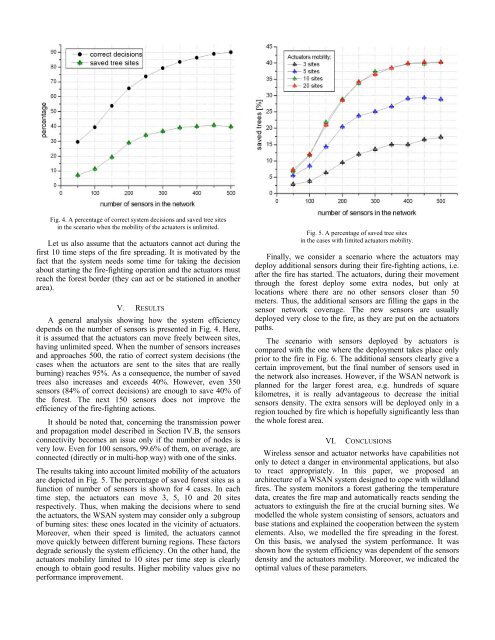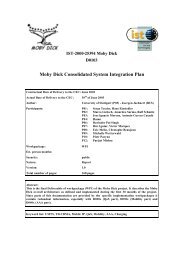WSAN Architecture for Wildland Fire-Fighting
WSAN Architecture for Wildland Fire-Fighting
WSAN Architecture for Wildland Fire-Fighting
You also want an ePaper? Increase the reach of your titles
YUMPU automatically turns print PDFs into web optimized ePapers that Google loves.
Fig. 4. A percentage of correct system decisions and saved tree sites<br />
in the scenario when the mobility of the actuators is unlimited.<br />
Let us also assume that the actuators cannot act during the<br />
first 10 time steps of the fire spreading. It is motivated by the<br />
fact that the system needs some time <strong>for</strong> taking the decision<br />
about starting the fire-fighting operation and the actuators must<br />
reach the <strong>for</strong>est border (they can act or be stationed in another<br />
area).<br />
V. RESULTS<br />
A general analysis showing how the system efficiency<br />
depends on the number of sensors is presented in Fig. 4. Here,<br />
it is assumed that the actuators can move freely between sites,<br />
having unlimited speed. When the number of sensors increases<br />
and approaches 500, the ratio of correct system decisions (the<br />
cases when the actuators are sent to the sites that are really<br />
burning) reaches 95%. As a consequence, the number of saved<br />
trees also increases and exceeds 40%. However, even 350<br />
sensors (84% of correct decisions) are enough to save 40% of<br />
the <strong>for</strong>est. The next 150 sensors does not improve the<br />
efficiency of the fire-fighting actions.<br />
It should be noted that, concerning the transmission power<br />
and propagation model described in Section IV.B, the sensors<br />
connectivity becomes an issue only if the number of nodes is<br />
very low. Even <strong>for</strong> 100 sensors, 99.6% of them, on average, are<br />
connected (directly or in multi-hop way) with one of the sinks.<br />
The results taking into account limited mobility of the actuators<br />
are depicted in Fig. 5. The percentage of saved <strong>for</strong>est sites as a<br />
function of number of sensors is shown <strong>for</strong> 4 cases. In each<br />
time step, the actuators can move 3, 5, 10 and 20 sites<br />
respectively. Thus, when making the decisions where to send<br />
the actuators, the <strong>WSAN</strong> system may consider only a subgroup<br />
of burning sites: these ones located in the vicinity of actuators.<br />
Moreover, when their speed is limited, the actuators cannot<br />
move quickly between different burning regions. These factors<br />
degrade seriously the system efficiency. On the other hand, the<br />
actuators mobility limited to 10 sites per time step is clearly<br />
enough to obtain good results. Higher mobility values give no<br />
per<strong>for</strong>mance improvement.<br />
Fig. 5. A percentage of saved tree sites<br />
in the cases with limited actuators mobility.<br />
Finally, we consider a scenario where the actuators may<br />
deploy additional sensors during their fire-fighting actions, i.e.<br />
after the fire has started. The actuators, during their movement<br />
through the <strong>for</strong>est deploy some extra nodes, but only at<br />
locations where there are no other sensors closer than 50<br />
meters. Thus, the additional sensors are filling the gaps in the<br />
sensor network coverage. The new sensors are usually<br />
deployed very close to the fire, as they are put on the actuators<br />
paths.<br />
The scenario with sensors deployed by actuators is<br />
compared with the one where the deployment takes place only<br />
prior to the fire in Fig. 6. The additional sensors clearly give a<br />
certain improvement, but the final number of sensors used in<br />
the network also increases. However, if the <strong>WSAN</strong> network is<br />
planned <strong>for</strong> the larger <strong>for</strong>est area, e.g. hundreds of square<br />
kilometres, it is really advantageous to decrease the initial<br />
sensors density. The extra sensors will be deployed only in a<br />
region touched by fire which is hopefully significantly less than<br />
the whole <strong>for</strong>est area.<br />
VI. CONCLUSIONS<br />
Wireless sensor and actuator networks have capabilities not<br />
only to detect a danger in environmental applications, but also<br />
to react appropriately. In this paper, we proposed an<br />
architecture of a <strong>WSAN</strong> system designed to cope with wildland<br />
fires. The system monitors a <strong>for</strong>est gathering the temperature<br />
data, creates the fire map and automatically reacts sending the<br />
actuators to extinguish the fire at the crucial burning sites. We<br />
modelled the whole system consisting of sensors, actuators and<br />
base stations and explained the cooperation between the system<br />
elements. Also, we modelled the fire spreading in the <strong>for</strong>est.<br />
On this basis, we analysed the system per<strong>for</strong>mance. It was<br />
shown how the system efficiency was dependent of the sensors<br />
density and the actuators mobility. Moreover, we indicated the<br />
optimal values of these parameters.
















